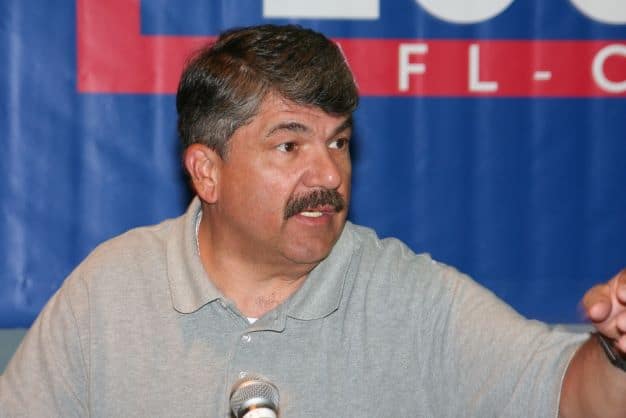
Kevin Vazquez is a staff attorney at the International Brotherhood of Teamsters. He graduated from Harvard Law School in 2023. The opinions he expresses on this blog are his own and should not be attributed to the IBT.
In the aftermath of the unexpected death of Richard Trumka on Thursday, the A.F.L.-C.I.O., as noted by the New York Times earlier today, faces a moment of decision – a “crossroads,” in the words of the Times. Despite Trumka’s impassioned and experienced leadership, his 12-year tenure at the head of the A.F.L.-C.I.O. coincided with the decline of organized labor in both union membership rates and the influence of labor unions on the political process. Under Trumka’s leadership, the federation prioritized political outcomes – rather than focusing on basic organizing and expanding union membership, a position for which many key figures in the labor movement passionately advocate – and, following his sudden unanticipated departure, these fundamental strategical decisions are being reconsidered. There are, broadly speaking, two factions concerning this issue that emerged during Trumka’s presidency. The first, with which Trumka himself more strongly identified, contends that the A.F.L.-C.I.O. should focus primarily on garnering political and policy support for its constituent unions, which includes lobbying in Washington, policy research and advocacy, developing relationships with important political figures, and an emphasis on communication and outreach. The other side maintains that the A.F.L.-C.I.O.’s role is to build and strengthen the labor movement from the ground up: to focus on organizing more workers and industries, including undocumented workers; expanding into emerging sectors of the economy, like gig work; and building alliances with organizations that promote other “progressive” causes, such as socialist, environmental, anti-racism, or anti-carceral groups – like, for example, the nascent climate-labor alliance, driven by the Democratic Socialists of America, which mobilized in support of the PRO Act earlier this year.
Trumka’s close relationship with President Biden, an outspokenly pro-labor president, and Biden’s enthusiastic support for the PRO Act appeared to indicate that the former strategy was enjoying some modicum of success. Taking a broader view, however, the evidence is unmistakable and overwhelming: The labor movement is in a protracted period of crisis, and, in 2021, less than seven percent of private-sector workers belong to a labor union – a number that, with some exceptions, has been declining for nearly 50 consecutive years. Moreover, despite the A.F.L.-C.I.O.’s efforts, the influence of labor unions on the political process has waned commensurately in the last half-century or so, and, notwithstanding the ardent support of many key members of the Democratic Party, the PRO Act, organized labor’s pinnacle hope, is still languishing, courtesy of the looming threat of filibuster, in the Senate. The Democratic Party, despite its ostensible pro-labor position, has thus far proven unable to muster the votes necessary to overcome a filibuster – or, alternatively, the political will necessary to abolish it. Some change, clearly, is necessary; the specific form that this change should assume, however, is less clear.
In any event, the A.F.L.-C.I.O. executive council will meet within three weeks to determine who will serve the remainder of Trumka’s term, which is due to expire next year, and these questions will surely be at the forefront of the discussion. As expected, key union leaders and senior staff, at least thus far, are breaking along predictable fault lines. Many of Trumka’s closest associates are backing Elizabeth Shuler, current Secretary-Treasurer of the federation, whom many “reformers” – those hoping to see the next president lead the federation into a new direction – regard with suspicion. Many reformers are instead backing Sara Nelson, president of the Association of Flight Attendants and one of the most popular and charismatic figures in the labor movement. Nelson, who supported Bernie Sanders in 2020, is an outspoken and dynamic progressive, and she has argued for investing tens of millions of dollars into organizing workers – and for diverting much of it from what the federation currently spends on political activities. These foundational questions will surely not be resolved in the next few weeks or even years, but their resolution, however it ultimately occurs, will doubtlessly have a profound influence on the labor movement, workers, and the political and economic systems in the coming decades.
In other news, the U.S. added 943,000 jobs last month, more than expected, and the unemployment rate fell to its lowest level since March 2020, the beginning of the pandemic, according to data released by the Department of Labor on Friday. Leisure and hospitality – two industries hit particularly hard by the pandemic – led the recovery, but education and health services also contributed significantly. Similarly, the number of Americans filing new claims for unemployment benefits further declined last week, and layoffs dropped to their lowest level in more than 20 years, according to the Department of Labor’s weekly unemployment claims report (which, according to Heidi Shierholz, currently the director of policy at the Economic Policy Institute and formerly chief economist at Obama’s Department of Labor, should finally eliminate the myth of a labor market shortage). Nonetheless, the economy is still at a crisis point, and it has, overall, shed 5.7 million jobs since the beginning of the pandemic last year. Millions of workers continue to desperately struggle, and, despite Biden’s latest extension of the eviction moratorium – welcome news, of course, which resulted from the continuous pressure exerted by progressive activists and politicians – at least ten million U.S. families, drowning beneath months of back rent, will be facing eviction when it inevitably expires if a more transformational, longer-term solution is not realized.
Perhaps with all this in mind, Biden, through press secretary Jenn Psaki, walked back his earlier indication that he would allow the expanded federal unemployment benefits to expire in September. In June, Biden – somewhat ambiguously – said that it “made sense” to permit the benefits to expire after Labor Day, apparently submitting to the harsh criticism leveled against the program by Republican politicians and conservative economists in the last year. On Friday, however, Psaki announced that the White House has not yet made a decision regarding the expiration of the expanded unemployment benefits, and she added that the administration had not seen any evidence that the states – led by Republican governors – which opted to end the expanded federal benefits early had any impact on the July jobs report. Many powerful Democrats, including Bernie Sanders, bolstered by the support of progressive groups and activists, have, in contrast to the Republicans’ punitive and cruel strategy, instead pushed to make the unemployment benefits permanent, effecting a permanent, far-reaching change in the U.S.’s social safety net – and perhaps even in nationwide labor relations. Regardless, the current pandemic unemployment assistance program is poised to expire on September 4, and it remains to be seen if Biden will take positive action to extend it or if he will yield to the vehement and unyielding anti-worker cruelty of the Republicans.
Finally, Randi Weingarten, president of the American Federation of Teachers, officially called for a vaccine mandate for teachers on Meet the Press on Sunday morning, saying the union should be “working with employers, not opposing them, on vaccine mandates.” Weingarten indicated an openness to vaccine mandates for teachers earlier this week but stopped short of officially endorsing the position – even if only as a matter of personal opinion. She is adding her voice to a complicated debate that has intensified in recent weeks. Many unions are understandably hesitant to support employers’ efforts to mandate vaccinations, raising concerns about the implications of such a policy, which would effectively permit employers to unilaterally make changes to workers’ conditions of employment without prior union consultation, and numerous teachers’ unions, in particular, have opposed vaccine mandates. Some unions have raised other issues as well, such as the lack of paid leave available to many blue-collar workers to either receive the vaccine or to stay home if they feel ill after the injection.
It must be noted, however, that it would be crude and excessively simplistic to ascribe such hesitancy to simple vaccine resistance. Unions have, on the contrary, almost universally called for the vaccination of their members, and they have routinely praised the efficacy and reliability of all three F.D.A.-approved vaccines. Union resistance to a vaccine mandate has little to do with vaccine hesitancy or misinformation and much to do with broader questions of relative workplace power and labor relations. Many view the former issue – whether employees should receive the vaccine, with which they almost all earnestly agree – as distinct from the latter, which is whether employers should be able to unilaterally mandate that employees receive the vaccine. Nonetheless, this issue is far from resolved, and it is one to keep an eye on in the coming weeks.






Daily News & Commentary
Start your day with our roundup of the latest labor developments. See all
July 15
The Department of Labor announces new guidance around Occupational Safety and Health Administration penalty and debt collection procedures; a Cornell University graduate student challenges graduate student employee-status under the National Labor Relations Act; the Supreme Court clears the way for the Trump administration to move forward with a significant staff reduction at the Department of Education.
July 14
More circuits weigh in on two-step certification; Uber challengers Seattle deactivation ordinance.
July 13
APWU and USPS ratify a new contract, ICE barred from racial profiling in Los Angeles, and the fight continues over the dismantling of NIOSH
July 11
Regional director orders election without Board quorum; 9th Circuit pauses injunction on Executive Order; Driverless car legislation in Massachusetts
July 10
Wisconsin Supreme Court holds UW Health nurses are not covered by Wisconsin’s Labor Peace Act; a district judge denies the request to stay an injunction pending appeal; the NFLPA appeals an arbitration decision.
July 9
the Supreme Court allows Trump to proceed with mass firings; Secretary of Agriculture suggests Medicaid recipients replace deported migrant farmworkers; DHS ends TPS for Nicaragua and Honduras